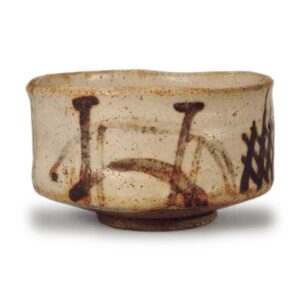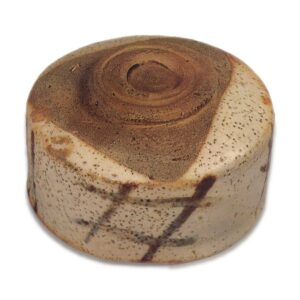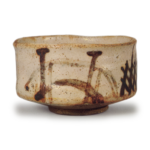

Height 7.9 cm, mouth diameter 12.7 cm, base diameter 6.3 cm
The well-melted glaze is truly smooth and white like snow. It is a slightly shallow semi-tubular bowl with a straightforward workmanship, and is small for a Shino bowl. The plump double-tiered stand is in good harmony with the soft taste of the clay. The body shows a gentle curving surface from the top to the waist, and the body is made on the potter’s wheel with a relaxed appearance, showing almost no traces of the use of a potter’s wheel. The four sides of the body are painted with pictures of bridges, cypress fences, calendars, and well girders, but it is not clear if there was any meaning to the arrangement of these pictures. The coloring of the painting is vivid, with a faint reddish hue appearing around the mouth rim and waist. The glaze which leaves the skin of the clay in a triangular shape centering on the high pedestal is an artifice often seen in Shino tea bowls.
It is one of the representative works of so-called “Sumiyoshi-te” tea bowls with a picture of a bridge.
On the front of the lid of the black lacquered inner box, “Sumiyoshi” is written in silver powder script, and on the back of the lid, “Gojobashi, Shino, Inoue family inherited” is written in small colored paper covered with sandpaper, and the writer, Mashida Bun’o, gave this bowl a supplementary inscription of “Gojobashi”. It was formerly in the collection of Marquis Inoue Seigai.








